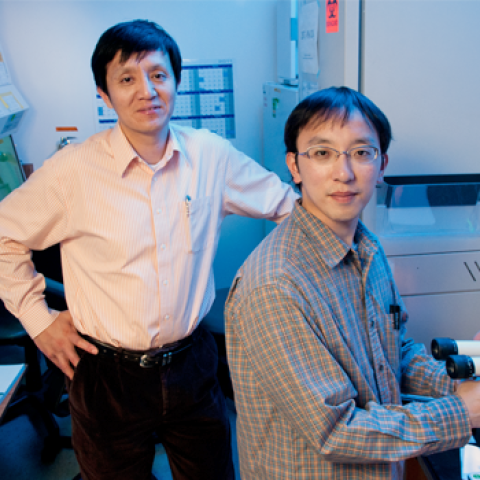Interdisciplinary Initiatives Program Round 4 – 2008
Matthew Scott, Developmental Biology
Thomas Baer, Applied Physics
Liqun Luo, Biology
Wing Wong, Statistics
Different classes of neurons rely on distinct sets of proteins to specify their development and function. One way to characterize the unique identities of these different neurons is to understand the genes that are active in particular neurons. Here, we describe a powerful method for isolating specific subpopulations of neurons from fruit fly (Drosophila) larval brains and determining the transcriptional expression profile of these neurons. Our initial studies focus on the insulin-producing cells (IPCs) in the larval brain, a group of fourteen neurons located in the central brain responsible for body growth control and sugar metabolism.
A team from the Scott and Luo labs is able to reproducibly identify fluorescence-labeled IPCs in frozen sections of the larval brain. Guided by Tom Baer’s expertise in laser-dissection microscopy, isolation of IPCs is conducted using a laser-capture microscope (Zeiss PALM). We are able to reliably capture small groups of 1-10 IPCs from each larval brain, which is composed of ~100,000 neurons. From these captured IPCs we have purified and amplified mRNA, and verified our samples are enriched for known IPC-specific mRNAs. We are currently building sequencing libraries for identifying unknown IPC-enriched mRNAs. Beyond identifying mRNAs expressed in IPCs, our ultimate goal is to identify various regulatory elements of IPC-expressed genes (in collaboration with Prof. Thomas Baer and Prof. Wing Wong) and understand how these elements specify the unique function and development of IPCs. Since fly IPCs are functionally analogous to mammalian pancreatic β-cells, what we learn from this project will have important implications for studies of diabetes.
In the future, we plan to extend our methods to characterizing specific transcriptional expression profiles of other types of neurons, such as serotonin-producing neurons, olfactory neurons, and motor neurons, to further our understanding of neuron identities at the transcriptional level. Ultimately, through this work we will attain a better understanding of the molecular profile of these various critical types of neurons, and help shed light on the biological phenomena, such as appetite, sleep, aggression, energy expenditure, and glucose homeostasis, which are controlled by neurons.




